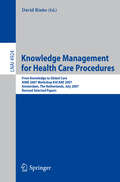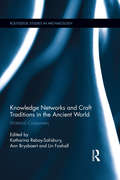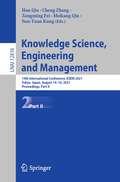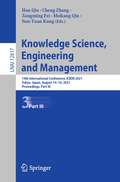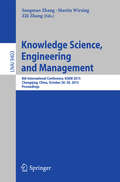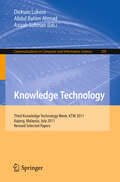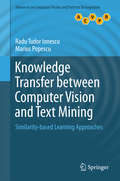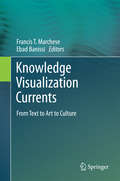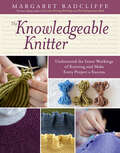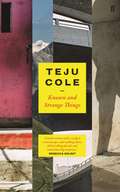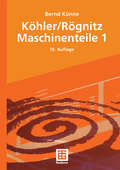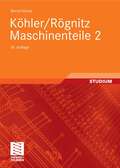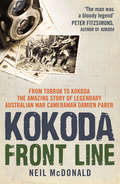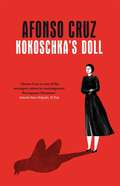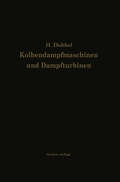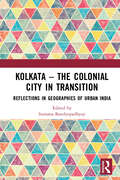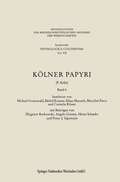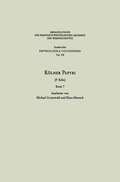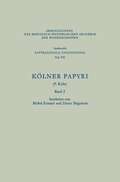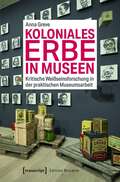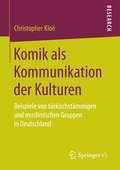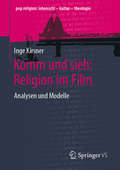- Table View
- List View
Knowledge Management for Health Care Procedures: From Knowledge to Global Care, AIME 2007 Workshop K4CARE 2007, Amsterdam, The Netherlands, July 7, 2007, Revised Selected Papers (Lecture Notes in Computer Science #4924)
by David RianoThe incursion of information and communication technologies (ICT) in health care entails evident bene?ts at the levels of security and e?ciency that improve not only the quality of life of the patients, but also the quality of the work of the health care professionals and the costs of national health care systems. Leaving research approaches aside, the analysis of ICT in health care shows an evo- tion from the initial interest in representing and storing health care data (i. e. , electronic health care records) to the current interest of having remote access to electronic health care systems, as for example HL7 initiatives or telemedicine. This sometimes imperceptible evolution can be interpreted as a new step of the progress path of health care informatics, whose next emerging milestone is the convergenceof current solutions with formal methods for health care kno- edge management. In this sense, K4CARE is a European project aiming at contributing to this progress path. It is centered on the idea that health care knowledge rep- sented in a formal waymay favor the treatment of home care patients in modern societies. The project highlights several aspects that are considered relevant to the evolution of medical informatics: health care knowledge production, health care knowledge integration, update, and adaptation, and health care intelligent systems.
Knowledge Networks and Craft Traditions in the Ancient World: Material Crossovers (Routledge Studies in Archaeology)
by Katharina Rebay-Salisbury Ann Brysbaert Lin FoxhallThis edited volume investigates knowledge networks based on materials and associated technologies in Prehistoric Europe and the Classical Mediterranean. It emphasises the significance of material objects to the construction, maintenance, and collapse of networks of various forms – which are central to explanations of cultural contact and change. Focusing on the materiality of objects and on the way in which materials are used adds a multidimensional quality to networks. The properties, functions, and styles of different materials are intrinsically linked to the way in which knowledge flows and technologies are transmitted. Transmission of technologies from one craft to another is one of the main drivers of innovation, whilst sharing knowledge is enabled and limited by the extent of associated social networks in place. Archaeological research has often been limited to studying objects made of one particular material in depth, be it lithic materials, ceramics, textiles, glass, metal, wood or others. The knowledge flow and transfer between crafts that deal with different materials have often been overlooked. This book takes a fresh approach to the reconstruction of knowledge networks by integrating two or more craft traditions in each of its chapters. The authors, well-known experts and early career researchers, provide concise case studies that cover a wide range of materials. The scope of the book extends from networks of craft traditions to implications for society in a wider sense: materials, objects, and the technologies used to make and distribute them are interwoven with social meaning. People make objects, but objects make people – the materiality of objects shapes our understanding of the world and our place within it. In this book, objects are treated as clues to social networks of different sorts that can be contrasted and compared, both spatially and diachronically.
Knowledge Networks and Craft Traditions in the Ancient World: Material Crossovers (Routledge Studies in Archaeology)
by Katharina Rebay-Salisbury Ann Brysbaert Lin FoxhallThis edited volume investigates knowledge networks based on materials and associated technologies in Prehistoric Europe and the Classical Mediterranean. It emphasises the significance of material objects to the construction, maintenance, and collapse of networks of various forms – which are central to explanations of cultural contact and change. Focusing on the materiality of objects and on the way in which materials are used adds a multidimensional quality to networks. The properties, functions, and styles of different materials are intrinsically linked to the way in which knowledge flows and technologies are transmitted. Transmission of technologies from one craft to another is one of the main drivers of innovation, whilst sharing knowledge is enabled and limited by the extent of associated social networks in place. Archaeological research has often been limited to studying objects made of one particular material in depth, be it lithic materials, ceramics, textiles, glass, metal, wood or others. The knowledge flow and transfer between crafts that deal with different materials have often been overlooked. This book takes a fresh approach to the reconstruction of knowledge networks by integrating two or more craft traditions in each of its chapters. The authors, well-known experts and early career researchers, provide concise case studies that cover a wide range of materials. The scope of the book extends from networks of craft traditions to implications for society in a wider sense: materials, objects, and the technologies used to make and distribute them are interwoven with social meaning. People make objects, but objects make people – the materiality of objects shapes our understanding of the world and our place within it. In this book, objects are treated as clues to social networks of different sorts that can be contrasted and compared, both spatially and diachronically.
Knowledge Science, Engineering and Management: 14th International Conference, KSEM 2021, Tokyo, Japan, August 14–16, 2021, Proceedings, Part II (Lecture Notes in Computer Science #12816)
by Han Qiu Cheng Zhang Zongming Fei Meikang Qiu Sun-Yuan KungThis three-volume set constitutes the refereed proceedings of the 14th International Conference on Knowledge Science, Engineering and Management, KSEM 2021, held in Tokyo, Japan, in August 2021.The 164 revised full papers were carefully reviewed and selected from 492 submissions. The contributions are organized in the following topical sections: knowledge science with learning and AI; knowledge engineering research and applications; knowledge management with optimization and security.
Knowledge Science, Engineering and Management: 14th International Conference, KSEM 2021, Tokyo, Japan, August 14–16, 2021, Proceedings, Part III (Lecture Notes in Computer Science #12817)
by Han Qiu Cheng Zhang Zongming Fei Meikang Qiu Sun-Yuan KungThis three-volume set constitutes the refereed proceedings of the 14th International Conference on Knowledge Science, Engineering and Management, KSEM 2021, held in Tokyo, Japan, in August 2021.The 164 revised full papers were carefully reviewed and selected from 492 submissions. The contributions are organized in the following topical sections: knowledge science with learning and AI; knowledge engineering research and applications; knowledge management with optimization and security.
Knowledge Science, Engineering and Management: 8th International Conference, KSEM 2015, Chongqing, China, October 28-30, 2015, Proceedings (Lecture Notes in Computer Science #9403)
by Songmao Zhang Martin Wirsing Zili ZhangThis book constitutes the refereed proceedings of the 8th International Conference on Knowledge Science, Engineering and Management, KSEM 2015, held in Chongqing, China, in October 2015. The 57 revised full papers presented together with 22 short papers and 5 keynotes were carefully selected and reviewed from 247 submissions. The papers are organized in topical sections on formal reasoning and ontologies; knowledge management and concept analysis; knowledge discovery and recognition methods; text mining and analysis; recommendation algorithms and systems; machine learning algorithms; detection methods and analysis; classification and clustering; mobile data analytics and knowledge management; bioinformatics and computational biology; and evidence theory and its application.
Knowledge Technology: Third Knowledge Technology Week, KTW 2011, Kajang, Malaysia, July 18-22, 2011. Revised Selected Papers (Communications in Computer and Information Science #295)
by Dickson Lukose Abdul Rahim Ahmad Azizah SulimanThis book constitutes the refereed proceedings of the Third Knowledge Technology Week, KTW 2011, held in Kajang, Malaysia, in July 2011. The 29 revised full papers presented together with 9 short papers were carefully reviewed and selected from 105 submissions. KTW 2011 consisted of a number of co-located events. This volume contains selected papers from the proceedings of the Third Malaysian Joint Conference on Artificial Intelligence (MJCAI 2011), the Third Semantic Technology and Knowledge Engineering (STAKE 2011), and the International Workshop on Semantic Agents (IWSA 2012).
Knowledge Transfer between Computer Vision and Text Mining: Similarity-based Learning Approaches (Advances in Computer Vision and Pattern Recognition)
by Radu Tudor Ionescu Marius PopescuThis ground-breaking text/reference diverges from the traditional view that computer vision (for image analysis) and string processing (for text mining) are separate and unrelated fields of study, propounding that images and text can be treated in a similar manner for the purposes of information retrieval, extraction and classification. Highlighting the benefits of knowledge transfer between the two disciplines, the text presents a range of novel similarity-based learning (SBL) techniques founded on this approach. Topics and features: describes a variety of SBL approaches, including nearest neighbor models, local learning, kernel methods, and clustering algorithms; presents a nearest neighbor model based on a novel dissimilarity for images; discusses a novel kernel for (visual) word histograms, as well as several kernels based on a pyramid representation; introduces an approach based on string kernels for native language identification; contains links for downloading relevant open source code.
Knowledge Visualization Currents: From Text to Art to Culture
by Francis T. Marchese and Ebad BanissiThis text reviews the evolution of the field of visualization, providing innovative examples from various disciplines, highlighting the important role that visualization plays in extracting and organizing the concepts found in complex data. Features: presents a thorough introduction to the discipline of knowledge visualization, its current state of affairs and possible future developments; examines how tables have been used for information visualization in historical textual documents; discusses the application of visualization techniques for knowledge transfer in business relationships, and for the linguistic exploration and analysis of sensory descriptions; investigates the use of visualization to understand orchestral music scores, the optical theory behind Renaissance art, and to assist in the reconstruction of an historic church; describes immersive 360 degree stereographic visualization, knowledge-embedded embodied interaction, and a novel methodology for the analysis of architectural forms.
The Knowledgeable Knitter: Understand the Inner Workings of Knitting and Make Every Project a Success
by Margaret RadcliffeKnitting is a combination of skill, determination, and adaptability. Whether you&’re looking for a suitable substitute yarn, trying to modify a pattern, or fixing a mistake, Margaret Radcliffe offers proven advice that will help you solve all of your knitting quandaries. With this definitive guide, you&’ll not only learn how to adjust armholes and shape collars, but why certain techniques work best in different situations. Radcliffe gives you the confidence and inspiration that will help you become a better, happier, and more confident knitter.
Known and Strange Things: Essays
by Teju ColeA blazingly intelligent first collection of essays from the award-winning author of Open City and Every Day Is for the Thief. With these pieces on politics, photography, travel, history and literature - many of which have become viral sensations, shared and debated around the globe - Teju Cole solidifies his place as one of today's most powerful and original voices. On page after page, deploying prose dense with beauty and ideas, he finds fresh and potent ways to interpret art, people and historical moments. Cole tells of his engagement with Virginia Woolf through her diaries, before reflecting on an episode of temporary blindness in New York. He looks at the rise of Instagram and interrogates the value of its images. He examines the transition of the candidate Obama, the avid reader, into a 'forever-war' president on the global stage. Persuasive and provocative, erudite yet accessible, Known and Strange Things is an opportunity to live within Teju Cole's wide-ranging enthusiasms, curiosities and passions, and a chance to see the world in surprising and affecting new frames.'A book written with a scalpel, a microscope, and walking shoes, full of telling details and sometimes big surprises.' Rebecca Solnit
Kochkunstfreiheit: Kochen und Kunst im Kontext des Verfassungsrechts
by Astrid FleischDas Grundgesetz gewährleistet die Freiheit der Kunst. Aber gewährleistet es auch die Freiheit der Kochkunst? Astrid Fleisch spannt einen Bogen zwischen der ewigen Frage nach der Definition von Kunst, dem Grundrecht der Kunstfreiheit als Folge der Menschenwürde und unserer überbordenden Kreativität am Herd. Sie verknüpft dabei rechtsphilosophische und kunsttheoretische Überlegungen mit einer anschaulichen Darstellung der Kochkunst und ihrer vielfältigen Phänomene. Anhand zahlreicher Beispiele beleuchtet sie lebendig und einprägsam die Frage nach der verfassungsrechtlichen Einordnung des Kochens und inspiriert so alle, die gerne essen oder selbst in der Küche tätig sind.
Köhler/Rögnitz Maschinenteile 1
by Bernd KünneDie Maschinenteile von Köhler/Rögnitz sind ein anerkanntes Standardwerk in der Maschinenelemente-Ausbildung ingenieurtechnischer Studiengänge. Das Lehr- und Arbeitsbuch vermittelt alle erforderlichen Kenntnisse über die wesentlichen Maschinenelemente. Neben den klassischen Gebieten des Maschinenbaus liefert der Köhler/Rögnitz auch Fachwissen planerischer, organisatorischer und logistischer Bereiche. Die Darstellung des Stoffes führt dabei von der Aufgabenstellung über die Funktion, Berechnung und Gestaltung zu Lösungsmöglichkeiten. Hierbei werden die erforderlichen Berechnungsgleichungen hergeleitet, die physikalischen Abhängigkeiten aufgezeigt und Problembereiche betrachtet. Für die 10. Auflage wurden alle zitierten Normen, Richtlinien und Literaturhinweise vollständig aktualisiert. Alle Kapitel sind mit Blick auf die Anforderungen gegenwärtiger Lehrinhalte und die Ingenieurpraxis überarbeitet worden. Besonderer Wert wurde auf die Überarbeitung des einführenden Kapitels zum Konstruieren und Gestalten von Maschinenteilen gelegt. Für die Konstruktionspraxis besonders hilfreich sind die zahlreichen gegenübergestellten Beispiele zum zweckmäßigen und unzweckmäßigen Konstruieren.
Köhler/Rögnitz Maschinenteile 2
by Bernd KünneDer Köhler/Rögnitz ist das anerkannte Standardwerk in der Maschinenelemente-Ausbildung ingenieurtechnischer Studiengänge. Die analytische Herangehensweise ermöglicht es, die Technische Mechanik mit den Lehrinhalten des Faches Maschinenelemente zu verbinden und damit für alle wesentlichen Konstruktionselemente auf dem Fundament der Mechanik und Werkstoffkunde ein grundlegendes Verständnis aufzubauen. Die Darstellung des Stoffes führt von der Aufgabenstellung über die Funktion, Berechnung und Gestaltung zu Lösungsmöglichkeiten. Die erforderlichen Berechnungsgleichungen werden hergeleitet, die physikalischen Abhängigkeiten aufgezeigt und Problembereiche betrachtet. Die 10. Auflage wurde in wesentlichen Bereichen unter der Berücksichtigung der technischen Entwicklungen überarbeitet und neu gestaltet. Neben einer inhaltlichen Überarbeitung wurden auch einige formale Änderungen vorgenommen. Weiterhin wurden die Normen den internationalen Standards entsprechend aktualisiert.
Kokoda Front Line: From Tobruk To Kokoda - The Amazing Story Of Legendary Australian War Cameraman Damien Parer
by Neil McDonaldDamien Parer was without doubt Australia’s greatest war photographer. He helped create the Anzac legend – and many, many of our iconic war images are his photographs. He served his apprenticeship as a stills photographer on the famous Chauvel film, 'Forty Thousand Horsemen', and was appointed Official Photographer covering the Australian fighting in the early days of World War II in Greece and Syria, and Tobruk. His most famous documentary is 'Kokoda Front Line!' , made during the darkest days of the campaign in mid-1942 (it went on to win Australia’s first Academy Award). His photographs and films brought the war home to Australians – and are now an integral part of our military history. He died in action – shot by Japanese machine gun fire, as he filmed an American advance on Peleliu. Originally published as WAR CAMERAMAN: THE STORY OF DAMIEN PARER, and later in an expanded form as DAMIEN PARER'S WAR, this colourful and authoritative story of a great Australian includes many of his most iconic photographs.
Kokoschka's Doll
by Afonso Cruz"A novel par excellence that is destined to become a classic' of almost byzantine splendour . . . At its best worthy of comparison with Gabriel García Márquez" Catherine Taylor, Irish Times"Afonso Cruz is one of the strongest voices in contemporary Portuguese literature" Antonio Saez Delgado, El PaisAt the age of forty-two, Bonifaz Vogel begins to hear a voice.But it doesn't belong to the mice or the woodworm, as he first imagines. Nor is it the voice of God, as he comes to believe. It belongs to young Isaac Dresner, who takes refuge in the cellar of Vogel's bird shop on the run from the soldier who shot his best friend. Soon Vogel comes to rely on it for advice: he cannot make a sale without first bending down to confer with the floorboards. Thus begins the story of two Dresden families, fractured and displaced by the devastating bombing of the city 1945, their fates not only intertwined, but bound also to that of a life-sized doll commissioned by the artist Oskar Kokoschka in the image of his lost lover.Based on a curious true story, Kokoschka's Doll is an imaginative and playful novel that transports the reader to Dresden, Paris, Lagos and Marrakesh, introducing them to an unforgettable cast of characters along the way.Translated from the Portuguese by Rahul Bery
Kolbendampfmaschinen und Dampfturbinen: Ein Lehr- und Handbuch für Studierende und Konstrukteure
by Heinrich DubbelDieser Buchtitel ist Teil des Digitalisierungsprojekts Springer Book Archives mit Publikationen, die seit den Anfängen des Verlags von 1842 erschienen sind. Der Verlag stellt mit diesem Archiv Quellen für die historische wie auch die disziplingeschichtliche Forschung zur Verfügung, die jeweils im historischen Kontext betrachtet werden müssen. Dieser Titel erschien in der Zeit vor 1945 und wird daher in seiner zeittypischen politisch-ideologischen Ausrichtung vom Verlag nicht beworben.
Kolkata — The Colonial City in Transition: Reflections in Geographies of Urban India
by Sumana BandyopadhyayThis book explores the spatial characteristics of the city of Kolkata in India in terms of the physical, economic, social, political, and environmental aspects of urban geography, and focuses upon the inherent processes that impact its transformation. It discusses different facets of urban geography and highlights the contemporary challenges of a major primate city in South Asia, which represents the conflicts between the traditional and the modern, the rich and the poor, the skyscrapers and the shanties. With its detailed empirical research and mapping exercises based on real-time remote sensing data, the book offers an understanding of a range of contemporary urban issues. It examines the spatial consequences of urban sprawl, land-use changes, ecological crisis, climate change, critical disasters, dynamics of the peri-urban interface, neighborhood restructuring, debates around heritage conservation, housing poverty, gray spaces, governance and the political landscape of the city. This book will be useful to students, teachers, and researchers of geography, especially human geography and urban geography, urban studies, urban development and planning, regional planning, social geography, governance, ecology, economics, and South Asian studies. It will also benefit urban planners, development professionals, and those interested in the study of the city of Kolkata and its transformations.
Kolkata — The Colonial City in Transition: Reflections in Geographies of Urban India
by Sumana BandyopadhyayThis book explores the spatial characteristics of the city of Kolkata in India in terms of the physical, economic, social, political, and environmental aspects of urban geography, and focuses upon the inherent processes that impact its transformation. It discusses different facets of urban geography and highlights the contemporary challenges of a major primate city in South Asia, which represents the conflicts between the traditional and the modern, the rich and the poor, the skyscrapers and the shanties. With its detailed empirical research and mapping exercises based on real-time remote sensing data, the book offers an understanding of a range of contemporary urban issues. It examines the spatial consequences of urban sprawl, land-use changes, ecological crisis, climate change, critical disasters, dynamics of the peri-urban interface, neighborhood restructuring, debates around heritage conservation, housing poverty, gray spaces, governance and the political landscape of the city. This book will be useful to students, teachers, and researchers of geography, especially human geography and urban geography, urban studies, urban development and planning, regional planning, social geography, governance, ecology, economics, and South Asian studies. It will also benefit urban planners, development professionals, and those interested in the study of the city of Kolkata and its transformations.
Kölner Papyri (Abhandlungen der Rheinisch-Westfälischen Akademie der Wissenschaften)
by Michael Gronewald Bärbel Kramer Zbigniew Borkowski Universität zu KölnKölner Papyri: P. Köln (Abhandlungen der Rheinisch-Westfälischen Akademie der Wissenschaften)
by Michael Gronewald Klaus Maresch Universität zu KölnKölner Papyri (Abhandlungen der Rheinisch-Westfälischen Akademie der Wissenschaften #7)
by Bärbel Kramer Dieter HagedornKoloniales Erbe in Museen: Kritische Weißseinsforschung in der praktischen Museumsarbeit (Edition Museum #42)
by Anna GreveMit dem Koalitionsvertrag von 2018 wurde das koloniale Erbe als Teil der deutschen Geschichte anerkannt. In einem Europa, in dem Nachfahren einstiger Kolonialmächte zusammen mit Menschen aus ehemals kolonisierten Ländern leben, gibt es sehr verschiedene Blicke in die Vergangenheit - geeint jedoch im Wunsch nach gesellschaftlichen Grundwerten in der Gegenwart. Daraus ergeben sich zentrale Fragen für die postkoloniale Museologie: Wie geht man mit Sammlungsgut aus kolonialen Kontexten um? Welche Erinnerungspolitik soll vertreten und wie kann struktureller Rassismus abgebaut werden? Anna Greve führt zur Beantwortung dieser Fragen erstmals die Kritische Weißseinsforschung mit ihren Begriffen und Methoden in die praktische Museumsarbeit ein.
Komik als Kommunikation der Kulturen: Beispiele von türkischstämmigen und muslimischen Gruppen in Deutschland
by Christopher KloëChristopher Kloë stellt in diesem Buch Samuel Huntingtons Hypothese eines Kampfes der Kulturen die Systematik einer Begegnung der Kulturen gegenüber. Diese wird durch das Mittel der medialen komischen Kommunikation von (Selbst-)Darstellungen anhand der Thesen von Homi K. Bhabha, Thilo Sarrazin, Alfred Schütz und Zygmunt Bauman erläutert. Der Vorgang einer ansteigenden Auseinandersetzung mit den jeweils Fremden auch in der Form von komischen Inszenierungen, die als analog zum ansteigenden Eintritt von Fremden in den lokalen sozialen Raum betrachtet wird, erläutert der Autor am Beispiel von türkischstämmigen und muslimischen Gruppen in Deutschland und im Vergleich zu Minderheiten im westlichen Kulturkreis.
Komm und sieh: Analysen und Modelle (pop.religion: lebensstil – kultur – theologie)
by Inge KirsnerDer erste große Teil dieses Bandes beschreibt – angefangen bei den „Zehn Geboten“ und ihrer Aktualisierung in „The Beach“ über das „Opfer“ Harry Potters, Blade Runners & Katniss´ in „Tribute von Panem" bis hin zu natürlichen und künstlichen Intelligenzen ("Planet der Affen" und "Ex Machina") – wie Religion in aktuellen Filmen thematisiert wird, die sich u. a. mit den Folgen der Digitalisierung und Mechanisierung sowie deren Auswirkungen auf das Menschenbild der Zukunft beschäftigen. Im zweiten Teil finden diese Themen praktisch-theologisch und liturgisch Gestalt, nämlich in Form von Filmgottesdiensten, die als Bausteine für Deutsch- und Religionsunterricht und für Gottesdienste in Schulen, Gemeinden und in der Erwachsenenbildung dienen können.
